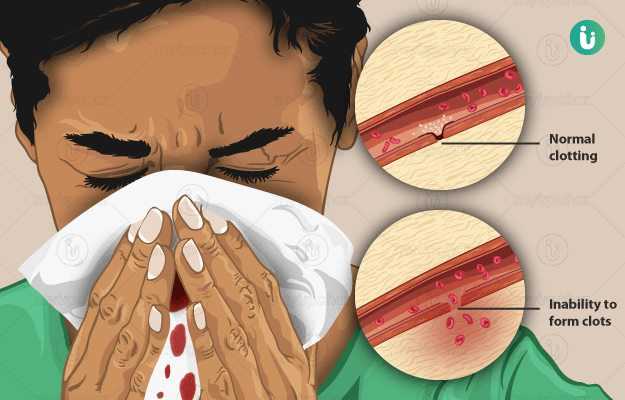What is Hemophilia?
Haemophilia is a rare, genetic condition which prevents the blood from clotting. This causes excessive bleeding even in minor injuries and sometimes internally without even injury. It is also called bleeder’s disease.
What are its main signs and symptoms?
Haemophiliaprevents the blood from clotting normally. Haemophilia patients may bleed for a longer time than others after an injury which can lead to death due to excessive loss of blood if not immediately attended to medically.
- Signs of external bleeding
- Bleeding in the mouth
- Heavy bleeding from a small cut
- Nose bleeding
- Signs of internal bleeding
- Blood in the urine and stool Read more: Blood in urine causes
- Large bruises from bleeding over the large muscles of the body
- Bleeding in the joints without any injury
- Bleeding in the brain after a minor bump on the head or more serious injury
What are its causes?
Haemophilia patients lack a necessary enzyme called thromboplastin due to which blood coagulation is impaired in these people. It mostly affects boys because it is an X-linked genetic trait. A hemophilic girl most often dies before birth itself.
There are two types of haemophilia:
- Hemophilia A
- It is characterised by lack of antihemophilic globulin (factor VII).
- About four-fifths of the cases of haemophilia are of this type.
- It is more severe.
- Therefore, even a very small cut may lead to continuous bleeding for a long time.
- Hemophilia B
- It is also known as Christmas disease.
- It results from a defect in plasma thromboplastin component (PTC or Factor IX).
How is it diagnosed and treated?
Diagnosis is made by a genetic testing which is followed by genetic counselling. Being a genetic condition, haemophilia cannot be cured. Since the main goal is to prevent joint bleeding and its complications, urgent medical management for persons with severe haemophilia A and B should be provided. Episodes of bleeding in haemophilia patients require Factor VII or Factor IX replacement therapy.
- Improved screening of blood and plasma donors have resulted in safer plasma-derived Factor VII and Factor IX concentrates.
- For persons with haemophilia A, viral safety should be the primary criterion for choosing between available blood transfusion products.
- For persons with mild or moderate haemophilia A, DDAVP should be used whenever appropriate.
- For persons with haemophilia B, high purity Factor IX concentrates should be used in specific circumstances to help blood clotting. In all other situations, the use of prothrombin complex concentrates can be considered as well.
- Surgery involving patients with haemophilia should only be undertaken after sufficient supplies of the necessary therapeutic products are available to cover the operative and post-operative periods. Such procedures require close cooperation between the physician, the blood bank or pharmacy, the surgeon and coagulation laboratory personnel.
(Read more: Blood clotting disorders types)

 OTC Medicines for Hemophilia
OTC Medicines for Hemophilia















